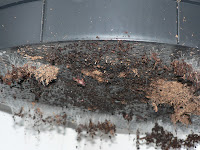Couple of things to consider -- first is when to plant. Most seed packets will give instructions on when to plant inside based on the approximate last frost date. I checked with the National Climate Data Center for my area, and I'm going with the date of May 10th. (The data shows dates for each location in three categories -- 90% chance of frost after that date, 50% chance, and 10% chance. I'm going with the 50% because I'm antsy.) So if a seed packet suggests planting indoors six weeks before the last frost date, then I will plant those seeds on or around March 29.
Next thing to consider is in what to plant. I use poo pots usually -- dried compressed cow manure made into cute little pots. No smell (there's never a smell from manure after

it's been dried and aged), no muss, but slightly more than I want to spend this year. On the cowpots.com site, 12 3" pots are $6.99 plus shipping. They're great pots, since you can just gently remove the bottoms and plant your seedlings with the pot right into the ground. The poo pot will decompose, adding amendments to the soil, and the seedling won't have transplant stress.
This year I'm pressed for cash, and what cash I do have I will spend on soil and seeds (more on this later).
The answer then is newspaper pots. I've got a lot of newspaper lying around (even though the Sunday Chicago Trib is terribly puny) because we just started getting the Sunday NYT (thank you, newspaper gods). And so the girls and I will be making newspaper pots.
Newspaper pots are good for starting seeds for a bunch o' reasons.
- Even though it's good to recycle, it's even better to reuse.
- Newspaper will decompose rather quickly, adding some nutrients to your soil.
- Some plants don't like being transplanted, and they don't like their roots being handled. Because you can plant newspaper pots right into the ground, the stress is minimized.
Check out this video for a quick tutorial on one way to make paper pots. Keep in mind -- these chicks use tape, which doesn't decompose. I'll be looking for another method of keeping the paper together later.









































